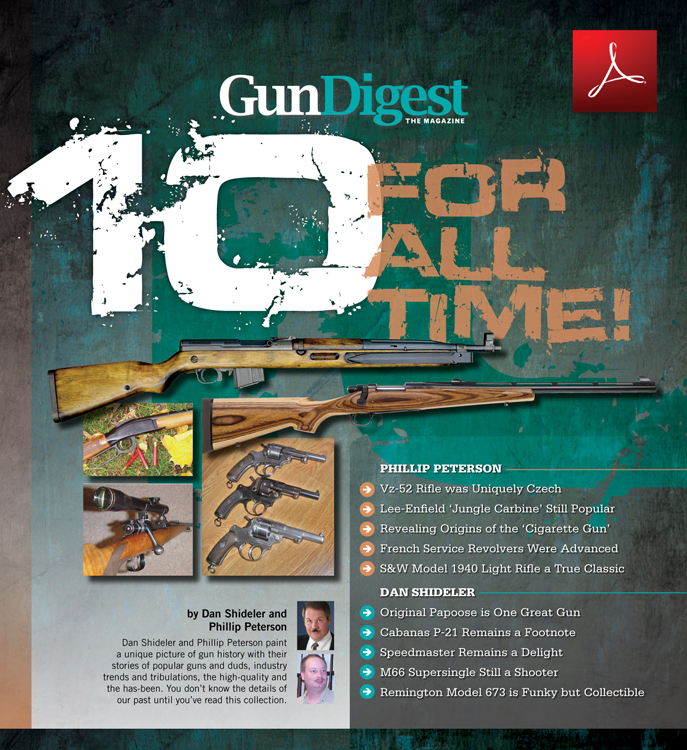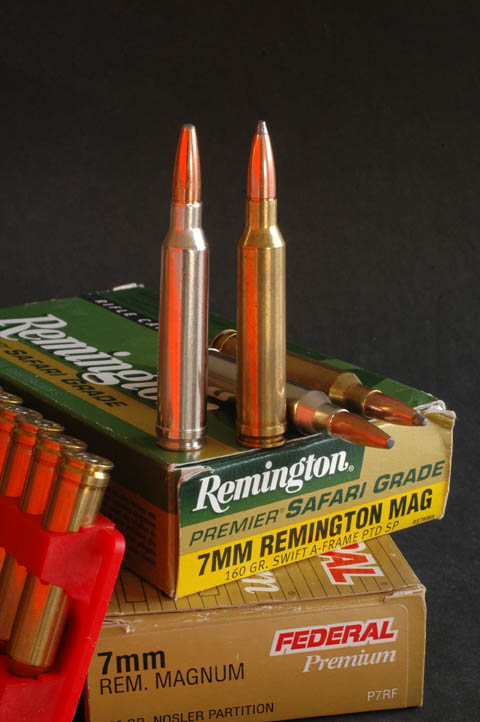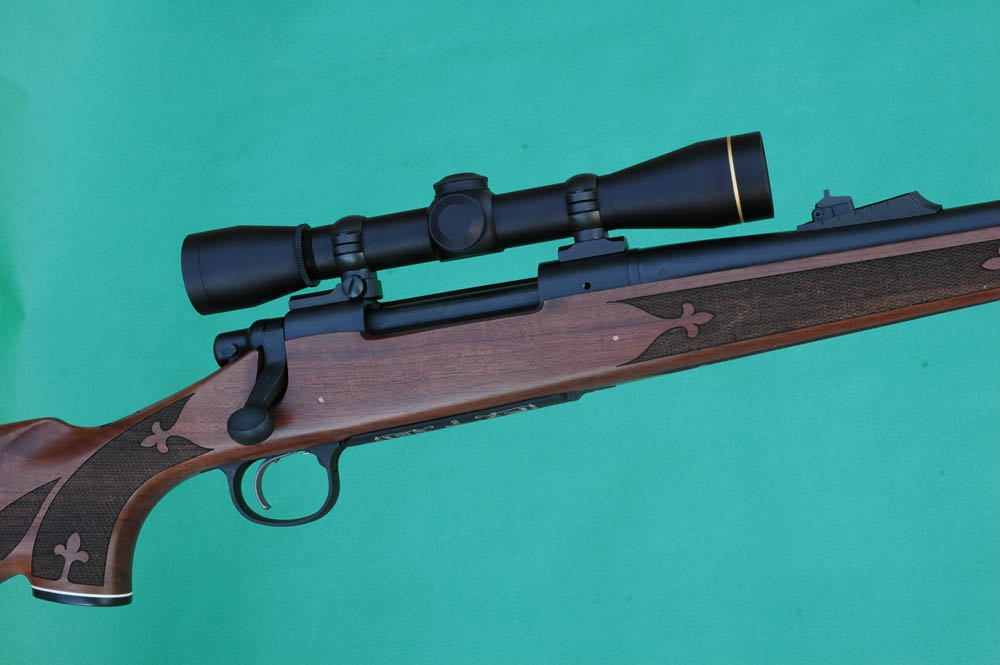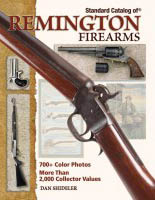Get More Gun History
 Check out 10 all-time favorite firearms in Gun Digest‘s exclusive download. Enter your e-mail in the box below. You'll also receive informative e-newsletters from Gun Digest and our marketing partners.
Check out 10 all-time favorite firearms in Gun Digest‘s exclusive download. Enter your e-mail in the box below. You'll also receive informative e-newsletters from Gun Digest and our marketing partners.
[form id=”148351″]

You may already know that this is the 50th anniversary year of Remington’s Model 700 rifle. While its ancestry dates to the 19th century, the Remington 700 really emerged from the 721/722 series, rifles that appeared in 1948. Developed by Merle “Mike” Walker and Homer Young, the 721/722 descended from the Remington 720, which appeared in 1941 to replace the .30 Express (1926) and its parent, the short-lived 30S (1921), both on the design of the 1917 Enfield.
The Model 721 and short-action 722 were economically built, with receivers cut from cylindrical tubing. Recoil lugs were thick steel washers sandwiched between receiver face and barrel shoulder. The clip-ring extractor, self-contained trigger assembly and stamped bottom metal pared costs. The bolt head with twin locking lugs was brazed (as was the bolt handle) to the bolt body. A bolt shroud supported the case head – an extra measure of security in the event of case rupture. Remington’s plunger ejector enabled it to keep “three rings of steel” around the case head.

The Remington 721 in .270 and .30-06 cost shooters $79.95; the 722 in .257 Roberts and .300 Savage cost $5 less. Beginning in 1949 the 721 chambered the .300 H&H Magnum for $89.95. In 1960, Remington offered the .280 in the 721, a year later the .264 Winchester Magnum. The 722 brought the .222 and .244 Remington to riflemen. The .308 made the roster in 1956, the .222 Remington Magnum and .243 in 1958 and 1959. High-grade A and B versions of both rifles were replaced in 1955 with ADL and BDL designations.
To my eye, there’s a Spartan elegance to the 721/722, and it is preferable to the angular lines and tasteless detailing on some modern rifles. But the series was admittedly plain. A perky follow-up from Remington designers Wayne Leek and Charlie Campbell was the Model 725, introduced in 1958. It featured 721/722 receivers but with hinged floorplate, checkered walnut, adjustable open rear sight. During 1961 and 1962, Remington’s Custom Shop built a Kodiak Model 725. Chambered in .375 and .458 Magnum, it had a 26-inch barrel with integral brake. Just 52 of these 9-pound rifles left the factory.
In 1962, Remington fielded a brand-new rifle. The Model 700 borrowed heavily from the 721/722 – in fact, the mechanism is the same. Early advertising focused on those three rings of steel (bolt shroud, chamber and receiver ring) supporting the cartridge head. A trim tang, a swept bolt with checkered knob and cast (not stamped) bottom metal distinguished the 700 from its forebears. So did a more appealing stock, its comb higher for scope use. Chasing accuracy, Mike Walker gave the 700 super-fast lock time (3.2 milliseconds), tight bore and chamber tolerances and a short leade.
Initially, the Model 700 came in two action lengths and two grades. Barrels wore iron sights. The ADL in .222, .222 Magnum, .243, 6mm, .270, .280, .308 and .30-06 retailed for $114.95. It had a blind magazine and pressed, point-pattern “checkering.” The BDL featured white-line spacers at buttplate, grip cap and forend tip, fleur-de-lis checkering for a price of $139.95. Remington also listed magnum versions of the new rifle: $129.95 for the ADL, $154.95 for the BDL. A special-order, safari-style 700, with braked 26-inch barrel in .375 or .458 Magnum, came from leftover 725 Kodiak stock. It was identically priced.

The Remington 700 got a big lift from the concurrent introduction of the 7mm Magnum cartridge. The only other magnum slated for first-year production was, ironically, Winchester’s similar but less ably presented .264. I’m told early magnum barrels actually taped at 23 ½ inches; by 1965 they were truly 24 inches, as advertised. The 20-inch barrels standard for the .243, 6mm, .270, .280, .308 and .30-06 were replaced by 22-inch tubes in 1964.
Five years later, the Remington 700 got its first facelift: a longer bolt shroud, jeweled bolt, restyled stock and machine-cut checkering.
By the mid 1970s, Remington had replaced the satin stock finish with tough RKW gloss. Remington first listed a left-bolt, left-stock 700 in 1973, in .270, .30-06 and 7mm Magnum. By then the Varmint Special had appeared, with heavy barrel sans sights. It chambered the .22-250 and, later, the .25-06—wildcat cartridges adopted by Remington in 1965 and 1969.
Beginning in 1966, Remington built M700s for military and police forces. Custom shop foreman Paul Gogol came up with a sniper rifle on a 40X action. Substituting the 700 mechanism, the company delivered 995 of these M-40 sniper rifles for service in Vietnam.
Models 721/722 and early 700 rifles had a side-switch thumb safety that arrested bolt and trigger. For hunters pushing through cover, a secured bolt handle is an asset. But a few accidental discharges as shooters unloaded rifles prompted a company recall. Remington’s gunsmiths removed the bolt-locking mechanism on returned rifles. All 700s manufactured since can be unloaded with the trigger blocked.
For most of its life, the 700 trigger could be adjusted for weight of pull (lower front screw), sear engagement (rear screw) and over-travel (upper front screw). In 2005, the X Mark Pro trigger, with a fixed 3 ½-pound pull, replaced it. Four years later a pull adjustment was added, range: 2 ½ to 4 ½ pounds.

The Remington Model 700 has been bored to nearly every centerfire round practical in a bolt action. Barrels that were once hot-hammer-forged now featured cold-hammered rifling. Early stainless barrels in magnum 700s were plated with copper, and then tin, which took a blued finish. In 1967 Remington changed to chrome-moly steel for every 700 barrel. Stainless steel later returned, but not blued.
Remington has added many versions of the 700 since my first hunts with the rifle. I particularly like my 5 ½-pound 700ti with titanium receiver (2001) and the Classic series (1978) – also the Sendero (1994).
Remington has a commemorative, closely matching the original 7mm Magnum – even to the white stock spacers and “reverse” fleur-de-lis checkering. This 700 wears better-than-average walnut.
Learn More About the Remington Model 700 and Beyond
 The Remington Model 700 is one of the most celebrated rifles of all-time, but it's only one firearm in the storied history of an influential gun manufacturer. Learn all about Remington's firearms from past to present in the Standard Catalog of Remington Firearms.
The Remington Model 700 is one of the most celebrated rifles of all-time, but it's only one firearm in the storied history of an influential gun manufacturer. Learn all about Remington's firearms from past to present in the Standard Catalog of Remington Firearms.
Click here to order the Standard Catalog of Remington Firearms by Dan Shideler for $15 (that's 50% off retail).
